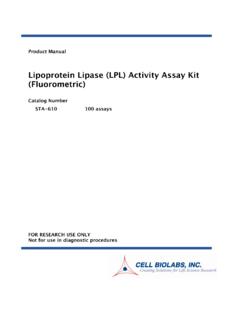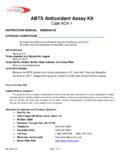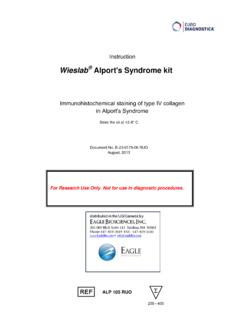Transcription of Renilla Luciferase Assay Kit - komabiotech.co.kr
1 Renilla Luciferase Assay Kit Catalog Number: 30004-1 (150 assays) 30004-2 (1000 assays) Contact Information Address: Biotium, Inc. 3423 Investment Blvd. Suite 8 Hayward, CA 94545 USA Telephone: (510) 265-1027 Fax: (510) 265-1352 Email: Website: Description Renilla Luciferase has been used as a reporter gene for studying gene regulation and function in vitro and in vivo1, 2. Recently, Renilla Luciferase has been widely used in multiplex transcriptional reporter assays or as a normalizing transfection control for Firefly Luciferase assay2, 3. Renilla Luciferase , a monomeric 36,000 Dalton protein, catalyzes coelenterazine oxidation by oxygen to produce light4 (Figure 1). The enzyme does not require post-translational modification for its activity and may function as a genetic reporter immediately following translation.
2 Coelenterazine native is the natural substrate for Renilla Luciferase . However, over a dozen of coelenterazine analogs have been synthesized, many of which are now commercially available from Biotium. These coelenterazine analogs all function as substrates for Renilla Luciferase with different properties in term of emission wavelength, cell membrane permeability, and quantum efficiency. Coelenterazine also emits light from enzyme-independent oxidation, a process known as autoluminescence. The autoluminescence is enhanced by superoxide anion and peroxynitrite in cells and tissues. Biotium s Renilla Luciferase Assay Kit is designed to provide a simple and sensitive method of detecting Renilla Luciferase . Through utilizing a special coelenterazine derivative and buffer formulation, this Assay kit is designed to yield reliable, linear results with minimal autoluminescence background and superior sensitivity (Figure 2).
3 Tech. 055 NHNNHOO+ O2 NNN-OHOOHOH+ CO2 + Light Figure 1. Bioluminescent reaction catalyzed by Renilla Luciferase . Luciferase Vector (ug) Relative Luminescence Units Figure 2. Dose response curve of transfected Renilla Luciferase genes. PC3 cells were transfected with g, g, g, and 1 g pRL-CMV vector (Promega) encoding Renilla Luciferase using Fugene 6 (Roche) in 6-well cell culture dishes. pGL2 Basic vector (Promega) was used as a control and for normalizing total DNA vector level to 1 g per transfection. Twenty-four hours after transfection, cells were harvested using 500 L lysis buffer contained in Biotium s Renilla Luciferase Assay Kit. To Assay Luciferase activity, 20 L of lysate from each sample was then added to 100 L of Assay buffer with Enhancer also in Biotium s Renilla Luciferase Assay Kit. Luminescence was measured on a luminometer (Turner Designs).
4 Light emission was integrated over 10 seconds without delay. For research use only. Page 2 Product Components Renilla Luciferase Assay Kit, 30004-1 (150 assays) 150 uL Coelenterazine, 100X 10 mL 5X Renilla Luciferase Assay Lysis Buffer 10 mL Renilla Luciferase Assay Buffer 10 mL Renilla Luciferase Assay Enhancer 1 Protocol Renilla Luciferase Assay Kit, 30004-2 (1000 assays) 1000 uL Coelenterazine, 100X 30 mL 5X Renilla Luciferase Assay Lysis Buffer 50 mL Renilla Luciferase Assay Buffer 50 mL Renilla Luciferase Assay Enhancer 1 Protocol Storage Conditions Store the Renilla Luciferase Assay Kit at 20 C. The components of the kit are stable at 20 C for three months and at 70 C for up to six months. Renilla Luciferase Assay solution ( Assay Buffer + Coelenterazine) should be prepared fresh for each use. Avoid repeated freeze-thaw cycles. Aliquot Renilla Luciferase Assay buffer and Enhancer for storage if necessary.
5 Preparation of Cell Lysates A. Preparation of Renilla Luciferase Assay Lysis Buffer Renilla Luciferase Lysis Buffer 1X working solution is prepared by adding 1 volume of 5X Renilla Luciferase Lysis Buffer to 4 volumes of distilled water and mixing well. The 1X Lysis Buffer may be stored at 4 C for up to one month. Store the 5X Renilla Luciferase Assay Lysis Buffer at 20 C. B. Lysis of Cells Cultured in Multiwell Plates 1. Remove the growth medium from the cultured cells and gently add a sufficient volume of phosphate buffered saline (PBS) to wash the surface of the culture vessel. Add Renilla Luciferase Assay Lysis Buffer using the volume recommended below for each type of well: 6 well culture plate 500 L 12 well culture plate 250 L 24 well culture plate 100 L 48 well culture plate 65 L 96 well culture plate 20 L 2. Place the culture plates on a rocking platform or orbital shaker with gentle rocking/shaking to ensure complete and even coverage of the cell monolayer with 1X Renilla Luciferase Assay Lysis Buffer.
6 Rock the culture plates at room temperature for 15 minutes. Note: Cultures that are overgrown are often more resistant to complete lysis and typically require an increased volume of Renilla Luciferase Lysis Buffer and/or an extended treatment period to ensure complete lysis and/or scraping cells off the culture plates. 3. Transfer the lysate to a tube or vial and place in 4 C for further Assay . Although it is not necessary, the lysate can be cleared by centrifugation for 30 seconds at top speed in a refrigerated microcentrifuge and transferred into a new tube. Store lysates at -70 C if not for immediate use. Renilla Luciferase Assay A. Preparation of Renilla Luciferase Assay Solution Prepare an adequate volume to perform the desired number of Renilla Luciferase Assays (50 L reagent per Assay ). Add 1volume of 100X Coelenterazine to 50 volumes of Renilla Luciferase Assay Buffer in a glass or siliconized polypropylene tube to derive Renilla Luciferase Assay For research use only.
7 Page 3 Solution (2X Coelenterazine solution). Renilla Luciferase Assay Solution (Coelenterazine + Buffer) should be prepared fresh and used within a day. B. Standard Protocol For manual luminometer: 1. Set up luminometer with appropriate parameters (delay time, integration time and sensitivity, etc.). 2. Add 20 L of cell lysate into a luminometer tube. 3. Add 50 L of Renilla Luciferase Assay Enhancer into the tube, flick the tube a few times for thorough mixing. 3. Add 50 L of Renilla Luciferase Assay Solution (2X Coelenterazine solution) to the tube, flick the tube a few times for thorough mixing. 4. Place tube in luminometer and initiate measurement. Luminescence is normally integrated over 10 seconds without delay. Other integration times may also be used. 5. If the luminometer is not connected to a printer or computer, record the Renilla Luciferase activity measurement.
8 6. Discard the reaction tube, and proceed to the next Renilla Luciferase Assay . For luminometer with injector: 1. Format the luminometer so that the injector dispenses 50 L. Prime the injector with Renilla Luciferase Assay Solution (2X Coelenterazine solution). 2. For each reaction, carefully add 20 L of cell lysate to an individual luminometer tube or to the wells of a multiwell plate. 2. Add 50 uL Renilla Luciferase Assay Enhancer into each reaction. 3. Place the samples in a luminometer. 4. Initiate measurement. This action will cause Renilla Luciferase Assay Solution to be injected into the reaction vessel and the measurement to be subsequently taken. Luminescence is normally integrated over 10 seconds without pre-read delay. Other integration times may also be used. 5. Record the Renilla Luciferase activity measurement. 6. If using a single tube luminometer, discard the reaction tube, and proceed to the next Renilla Luciferase Assay reaction.
9 If using a plate luminometer, the luminometer will automatically begin injecting Renilla Luciferase Assay Solution into the next well indicated on the luminometer plate. Determination of Assay Backgrounds The expression of a Luciferase reporter is quantified by the luminescence produced above background levels. In most cases, because the background created by the reagent in the absence of Renilla Luciferase is very small compared to the Luciferase signal, this Luciferase activity is directly proportional to total luminescence. However, when measuring very small amounts of Luciferase it is important to subtract the background signal from the measurement of total luminescence. Background luminescence can be obtained by using lysate from untransfected cells or cells transfected with a control vector. The background luminescence can be subtracted from subsequent measurements of Renilla Luciferase .
10 For research use only. Page 4 References 1. Bhaumik S. et al. (2004) Optical imaging of Renilla Luciferase , synthetic Renilla Luciferase , and firefly Luciferase reporter gene expression in living Biomed Opt. 9, 578-86. 2. Matijasevic Z. et al. (2001) Repair of sulfur mustard-induced DNA damage in mammalian cells measured by a host cell reactivation Assay . Carcinogenesis. 22, 661-4. 3. Nieuwenhuijsen BW. et al. (2004) A dual Luciferase multiplexed high-throughput screening platform for protein-protein interactions. J Biomol Screen. 8, 676-84. 4. Matthews, , Hori, K. and Cormier, (1977) Purification and properties of Renilla reniformisluciferase. Biochemistry 16, 85 91. For research use only. Page 5









